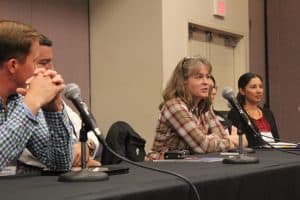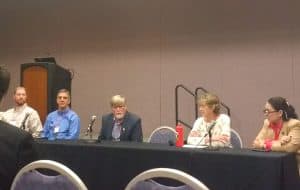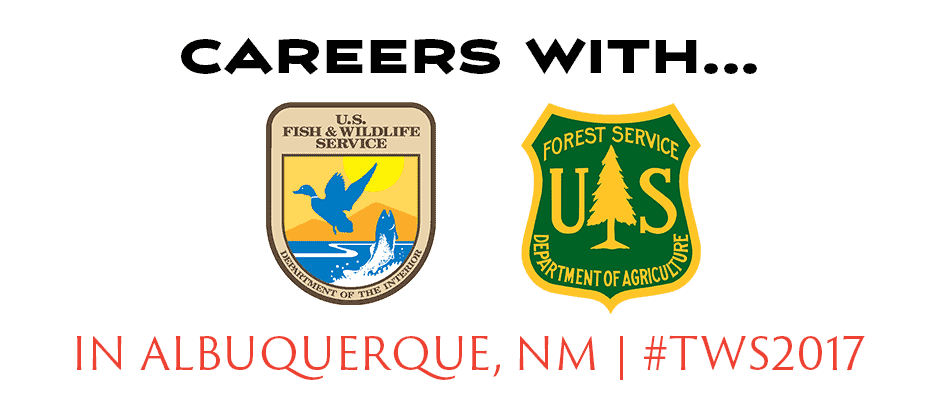Share this article
‘Go where your passion takes you’
Dozens of students attended career sessions with the U.S. Fish and Wildlife Service and Forest Service Wednesday at TWS’ 24th Annual Conference in Albuquerque, N.M. Professionals from these federal agencies shared their experiences, pointers and opportunities available with their employers.
The USFWS event featured five biologists describing their unique career paths and the insights they gained.
Scott Aiken, the USFWS’ national Native American liaison, suggested volunteering as a first step into the federal wildlife profession. He’s been at it for 25 years and first volunteered as a young biologist with a USFS project on marbled murrelets.
 “If you want to do wildlife, you can do wildlife, but your commitment has to be set as a passion to protect and serve fish and wildlife and their habitats,” he said. “If you’re a service employee, you’re service before employee. Find areas that help you see a broader perspective on wildlife. Find a good mentor.”
“If you want to do wildlife, you can do wildlife, but your commitment has to be set as a passion to protect and serve fish and wildlife and their habitats,” he said. “If you’re a service employee, you’re service before employee. Find areas that help you see a broader perspective on wildlife. Find a good mentor.”
Gail Collins serves in the National Wildlife Refuge system in Oregon and Nevada and has been with the USFWS for two decades. Initially interested in becoming a vet, she changed her major two weeks after getting hooked on a wildlife biology course, built experience by “harassing everybody for opportunities” and ended up spending a decade darting Alaskan mammals from helicopters.
“Take those risks,” she said. “Don’t get stuck on specific species. Expand your horizons to make yourself well-rounded and competitive. Do everything to gain experience. Take unpaid internships, even if it’s a week. Talk to people and see how they can help you.”
Kelly VanBeek, of the Midwest migratory bird program, agreed.
“Get broad experience with multiple agencies and nonprofits,” she said. “Gain people skills. Writing a cover letter, explain you’ll do something with that passion.”
The afternoon session was led by five Forest Service employees who had valuable information for students considering wildlife jobs with the agency.
What’s in the USFS for the hundreds of wildlife biologists it employs?
“I’ve worked with many iconic species — elk, deer, grizzly bears, spotted owls, goshawks, pollinators,” said Brian Dykstra, the Southwest’s wildlife program leader who’s traveled all over the West since joining the USFS in 1982 as a volunteer ranger. “The diversity of interest areas you work on is tremendous. There’s research and development and international programs. If you like a breadth of challenges and opportunities, the USFS is a great agency.”
 Brian Dickerson said that one of his favorite parts of his USFS position in South Dakota was collaborating with a wide range of partners, including state and native organizations.
Brian Dickerson said that one of his favorite parts of his USFS position in South Dakota was collaborating with a wide range of partners, including state and native organizations.
“By interacting with people who have different missions, you learn how to give a little,” he said.
Dickerson advised students to take botany seriously and know how to identify plant species. He also recommended training in GIS and statistics, tools that are increasingly used on the job.
Dykstra emphasized the crucial role of networking in the federal wildlife field.
“Having a good network of partners, coworkers and others who help you be successful is important,” he said. “Integrating different resource areas is critical to success. The more you can build your network, the more successful you’ll be. It’s not only what you know, it’s also who you know in getting that next job, in making that next project work.”
Listen to others and stay in touch with fellow students because they’re potential future colleagues, said national wildlife ecologist Sandy Boyce, who’s enjoyed almost three decades with the Forest Service. He told students to ensure they complete the required coursework listed on the U.S. Office of Personnel Management website for wildlife biologists under series 0486 and natural resource managers under series 0401.
“Go where your passion takes you because that’ll sustain you through good and bad times,” Boyce said.








